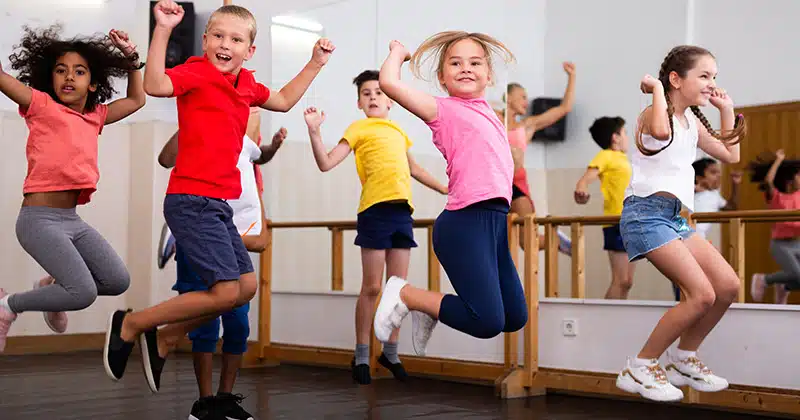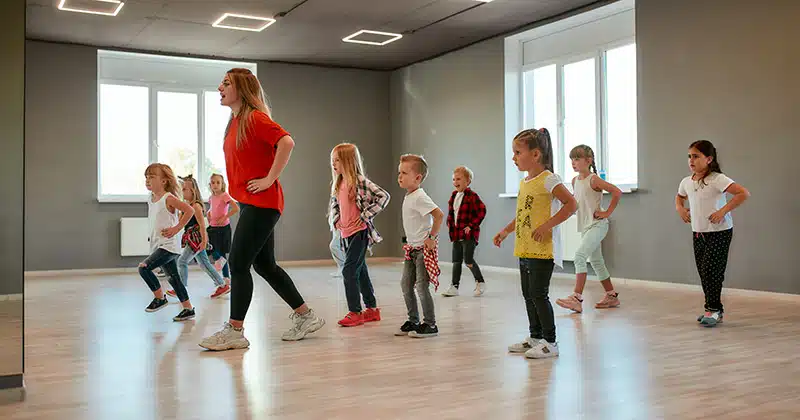If you own or manage a dance studio, you’re always looking for ways to make classes something more. More engaging or more fun. More educational or more inclusive.
Adding games is the perfect way to enhance your lessons. They can work in various settings and appeal to a wide range of students, regardless of level.
Read on to see how dance games can give your classes that something extra.

Why Play Games in Dance Class?
There are multiple advantages to incorporating games into dance classes. While this may feel more natural with young children, even teens and adults see benefits.
A few pluses to consider:
- Games can help shy students feel comfortable and part of the group.
- Some games encourage teamwork and group collaboration.
- Students learn differently. Some may remember material better when it’s part of a game.
- Games use a different part of the brain than traditional dance lessons. This helps both developing minds and adults who like staying sharp.
- Using play can make introducing complex concepts easier and more accessible.
- Dance games can make senior classes feel more fun and less like exercise or physical therapy.
- For advanced students who work hard in dance class, games offer a nice break from the normal routine.
You don’t have to devote an entire class to games. You can use dance games at the beginning or end of a lesson as part of the warm-up or cooldown. Or you can add a game in the middle, such as when teaching new choreography.
Dance games can be a regular part of class, a quick break, or a reward for good behavior with little ones. For example, knowing they get to play a game at the end of class is a way to entice preschoolers to pay attention earlier.
RELATED ARTICLE: The Importance of Fostering Inclusion in Your Dance Studio—Why It Matters
6 Engaging Games for Dance Classes of All Ages
Looking for some dance games you can try at your studio? Here are some examples you can use with students of different ages:
1. Musical Chairs
Most people have played Musical Chairs as a kid. This is the classic game where music is played, and when it stops, everyone must find a seat. The catch is that there’s always at least one less seat available than the number of participants.
This game is great for preschoolers because it teaches them to listen to musical cues. Their auditory attention will improve when you play games like this with them.
It’s not always the best game for older kids, as it can sometimes get too competitive. There is a way to make this work so there is no shoving or pushing when the music stops. Make everyone perform dance moves when the music is playing. And be sure to space the seats far apart to minimize ambiguity over who gets a seat.
2. Simon Says
The old-fashioned game of Simon Says dates back to at least the mid-19th century. It is another fantastic option for very young students. Like Musical Chairs, it encourages good listening in class. It also helps kids learn directions, including left and right.
With younger students, simply asking for basic movements like these is enough:
- Step forward, backward, or to the side
- Jump in any direction
- Bend forward and touch the toes
- Move the arms like windmills
- Stretch sideways
- Balance on one leg
- Jump or jog in place
You can use this game with elementary school students, too. Substitute actual dance movements—like tendu, arabesque, or pas de chat—with slightly older pupils.
3. Dance Freeze
This game can be adapted for virtually any student level. Play music appropriate for the type of class. When the music stops, students must either freeze where they are or strike a pose announced by the teacher.
Dance Freeze helps small children listen carefully and improve basic balance. With more mature kids, it can be used to balance on pointe or hone adagio positions, such as arabesque and attitude.
Balance is also an issue with many senior citizens. Dance Freeze can help them work on balance skills in a fun way.
RELATED ARTICLE: Most Popular Dance Studio Music
4. Warm-Up Cards
Using warm-up cards is a way to let kids feel like they have more say in the class structure. Create a deck of cards with a different warm-up exercise on each one.
At the start of class, ask a “student of the day” (which should rotate) to pick a half dozen cards for that day’s warm-up. You can also use this game at the end of class for cooldown by adding more stretching since students will be fully warmed up by then.
Before using this game, go through all the exercises on the cards with the class. This ensures everyone is familiar with them. In general, warm-ups are more helpful when students aren’t focused on learning new steps. Instead, you want them to concentrate on increasing circulation and range of motion.
5. Dance Hats and Scarves
Using costume props in dance classes can help bashful students open up. It helps students of all ages use their arms and hands more gracefully. And little children will love the dress-up aspect of it.
You can use the Dance Hats and Scarves game with students at both ends of the age spectrum.
More than 12% of Americans have mobility disabilities. Senior citizens often have limited lower body mobility. They can use these items for increased movement and expressiveness.
The instructor can incorporate hats and scarves into regular choreography. Or they can create movements specifically for the game.
Want to use this game with older kids, too? It’s particularly good for advanced students who need to work with these costume items for Broadway or story ballet choreography.
6. Animal Charades
In this game, students act out how various animals move. Their classmates must guess which animal is being represented.
You can make this game a competition by dividing the class into teams. Whichever team has the most correct guesses wins. It’s a good alternative for elementary and middle school kids.
The charades don’t necessarily have to be literal imitations of the animal. The goal is to encourage kids to demonstrate different movement qualities. For example, they can explore the languid grace of a cat as compared to the lumbering heaviness of an elephant.
Putting words to these movement qualities will help later in other classes. When you want that taffy-like stretch of a cat in développé at the barre, you can use descriptive words discussed during the game.
RELATED ARTICLE: Dance Studio Setup Ideas—What You Need to Know

How To Start Using Games in Your Dance Class Today
The great thing about dance games is you can start using them in your classes right away. Here are some expert tips to add games to your dance studio:
- Keep a notebook of fun games for each class level. If you have an instructor out and need to use a substitute, they have a ready lesson plan at hand, just in case.
- Encourage students to come up with their own games in addition to the ones suggested above. They can put their dance creativity to use in an entirely new way.
- Make sure everyone feels comfortable participating in dance games. Avoid making the same students leaders all the time. A game is the perfect chance for students who might struggle a bit to be in charge.
- Make games more about fun, inventiveness, and camaraderie, not competitiveness. Use your judgment to split up groups or avoid games with points if you notice games having a negative effect.
- Build a chest of props or costumes you can use to enhance some games. Younger children, in particular, love this idea.
- Host a special dance game night where students can bring a friend or family member. It’s a fantastic chance to grow your dance studio’s roster when newbies see how fun your classes are!
RELATED ARTICLE: How To Run a Successful Dance Studio


